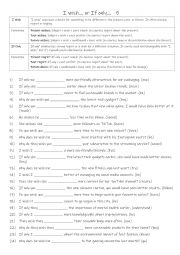
|
B1-B2 I wish�. or If only�. 5
They help students communicate feelings like hope, frustration, or disappointment and strengthen their understanding of unreal or hypothetical grammar forms, making their communication more advanced and expressive. These structures are vital for clear, expressive, and advanced communication in both spoken and written contexts. First, students need ...
Level: intermediate
Age: 12-100
Type:
Downloads: 109
|
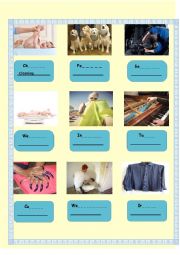
|
What needs to be done? Part 4 of 5
Students to complete the verb then make sentences (oral or written) using need/s + verb ing for each picture. For higher level students where possible they think of another suitable synonym which could also be used. See example on first picture.
Level: elementary
Age: 9-100
Type: activity-card
Downloads: 261
|
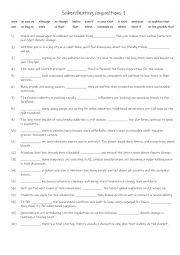
|
B2-C1 20 subordinating conjunctions 1
Students should learn subordinating conjunctions like since, as soon as, although, before, and others because they help create more complex and meaningful sentences by connecting dependent and independent clauses. These conjunctions allow students to express relationships between ideas, such as time, condition, contrast, and purpose. For example, t...
Level: advanced
Age: 11-100
Type:
Downloads: 113
|
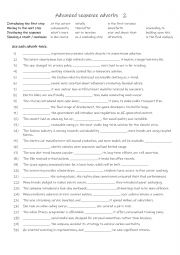
|
15 advanced sequencing adverbs 2
First, students need to familiarise themselves with the 15 adverbs and check their meaning and use. Then they read the sentences to see which adverb is needed to complete the sentence. Each adverb is used 2 times! Answers on page 2.
Level: intermediate
Age: 10-100
Type:
Downloads: 124
|
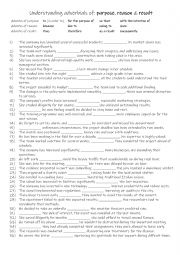
|
B1+ -C1 Understanding 12 adverbials of purpose, reason & result 1
Learning to use adverbials of purpose, reason, and result enhances clarity and coherence in communication. These adverbials allow students to express intentions, causes, and outcomes clearly, making their speech and writing more logical and well-structured. Mastering these adverbials also helps them link ideas smoothly, providing a stronger flow i...
Level: intermediate
Age: 9-100
Type:
Downloads: 105
|
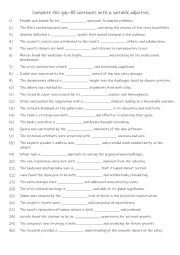
|
C1-C2 Complete the gap-fill sentences with a suitable adjective.
Students read the sentences and complete the gap-fill using a suitable adjective. This worksheet is only suitable for advanced students due to the vocabulary used.However; the teacher could pre-teach the 30 adjectives, then it would be suitable for B2 level students. A speaking reinforcement activity could be used with most of the statements for st...
Level: advanced
Age: 14-100
Type: worksheet
Downloads: 141
|
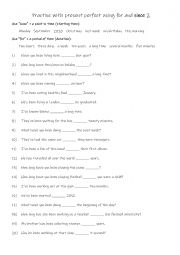
|
A1+-A2 Practise with present perfect using for and since 2
Students read the sentences and complete the sentences with the required word. Answers on page 2.
Level: elementary
Age: 8-100
Type:
Downloads: 116
|
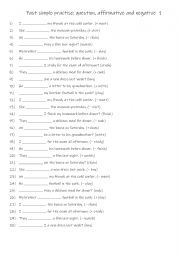
|
A1 Past simple practise with: question, affirmative and negative 1
Learning the past simple tense with questions, affirmative, and negative sentences is essential for students as it enables effective communication about past events. It provides a foundation for understanding grammar and constructing basic sentences, which is crucial for daily conversations. Mastering these forms ensures students can ask questions,...
Level: elementary
Age: 8-100
Type:
Downloads: 102
|
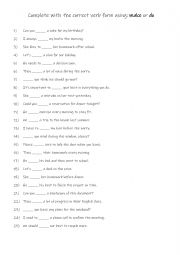
|
Make or do collocations practise
Students read the questions/ sentences and work out if it needs to be completed with either make or do. They will need to conjugate the verb for some sentences. This worksheet is suitable for A2-B1 level students. Answers on page 2
Level: elementary
Age: 10-100
Type:
Downloads: 110
|
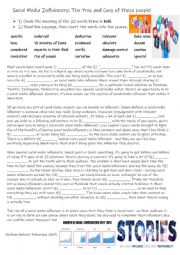
|
The phenomenal rise of �Social Media Influencers�: The Pros and Cons of these people!
500-Word reading article with a 20-word gap fill exercise about �Influencers�. It takes an in-depth look at their positive and negative influence in changing people�s minds and opinions on today�s topics of interest. An answer sheet is included. For higher level students they could be put in groups to give / present their opinions in a presentation...
Level: elementary
Age: 12-100
Type: worksheet
Downloads: 2217
|












